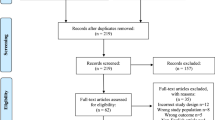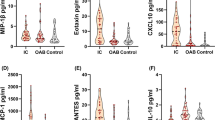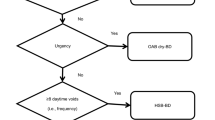Abstract
The urologic chronic pain conditions such as chronic prostatitis/chronic pelvic pain syndrome and interstitial cystitis are syndromes whose evaluation and management are controversial. Part of the difficulty in diagnosis and therapy is the heterogeneity of etiologies and symptoms. We propose a six-domain phenotype, which can classify these patients clinically and can direct the selection of therapy in the most evidence based multimodal manner. The domains are urinary, psychosocial, organ specific, infection, neurologic and tenderness of skeletal muscles. This system is flexible and responsive to new biomarkers and therapies as their utility and efficacy are proven.
This is a preview of subscription content, access via your institution
Access options
Subscribe to this journal
Receive 4 print issues and online access
$259.00 per year
only $64.75 per issue
Buy this article
- Purchase on Springer Link
- Instant access to full article PDF
Prices may be subject to local taxes which are calculated during checkout


Similar content being viewed by others
References
Krieger JN, Nyberg LJ, Nickel JC . NIH consensus definition and classification of prostatitis. JAMA 1999; 282: 236–237.
Taylor BC, Noorbaloochi S, McNaughton-Collins M, Saigal CS, Sohn MW, Pontari MA et al. Excessive antibiotic use in men with prostatitis. Am J Med 2008; 121: 444–449.
Shoskes DA, Katz E . Multimodal therapy for chronic prostatitis/chronic pelvic pain syndrome. Curr Urol Rep 2005; 6: 296–299.
Fall M, Oberpenning F, Peeker R . Treatment of bladder pain syndrome/interstitial cystitis 2008: can we make evidence-based decisions? Eur Urol 2008.
Sairanen J, Tammela TL, Leppilahti M, Onali M, Forsell T, Ruutu M . Potassium sensitivity test (PST) as a measurement of treatment efficacy of painful bladder syndrome/interstitial cystitis: a prospective study with cyclosporine A and pentosan polysulfate sodium. Neurourol Urodyn 2007; 26: 267–270.
Dell JR, Parsons CL . Multimodal therapy for interstitial cystitis. J Reprod Med 2004; 49: 243–252.
Meeus M, Nijs J . Central sensitization: a biopsychosocial explanation for chronic widespread pain in patients with fibromyalgia and chronic fatigue syndrome. Clin Rheumatol 2007; 26: 465–473.
Tripp DA, Nickel JC, Wang Y, Litwin MS, McNaughton-Collins M, Landis JR et al. Catastrophizing and pain-contingent rest predict patient adjustment in men with chronic prostatitis/chronic pelvic pain syndrome. J Pain 2006; 7: 697–708.
Litwin MS, McNaughton-Collins M, Fowler Jr FJ, Nickel JC, Calhoun EA, Pontari MA et al. The National Institutes of Health chronic prostatitis symptom index: development and validation of a new outcome measure. J Urol 1999; 162: 369–375.
O'Leary MP, Sant GR, Fowler FJJ, Whitmore KE, Spolarich-Kroll J . The interstitial cystitis symptom index and problem index. Urology 1997; 49: 58–63.
Parsons CL, Dell J, Stanford EJ, Bullen M, Kahn BS, Waxell T et al. Increased prevalence of interstitial cystitis: previously unrecognized urologic and gynecologic cases identified using a new symptom questionnaire and intravesical potassium sensitivity. Urology 2002; 60: 573–578.
Staab JP, Datto CJ, Weinrieb RM, Gariti P, Rynn M, Evans DL . Detection and diagnosis of psychiatric disorders in primary medical care settings. Med Clin North Am 2001; 85: 579–596.
Osman A, Barrios FX, Kopper BA, Hauptmann W, Jones J, O'Neill E . Factor structure, reliability, and validity of the Pain Catastrophizing Scale. J Behav Med 1997; 20: 589–605.
Nickel JC, Shoskes D, Wang Y, Alexander RB, Fowler JEJ, Zeitlin S et al. How does the pre-massage and post-massage 2-glass test compare to the Meares–Stamey 4-glass test in men with chronic prostatitis/chronic pelvic pain syndrome? J Urol 2006; 176: 119–124.
Potts JM, Ward AM, Rackley RR . Association of chronic urinary symptoms in women and Ureaplasma urealyticum. Urology 2000; 55: 486–489.
Rosenberg MT, Page S, Hazzard MA . Prevalence of interstitial cystitis in a primary care setting. Urology 2007; 69: 48–52.
Shoskes DA, Zeitlin SI, Shahed A, Rajfer J . Quercetin in men with category III chronic prostatitis: a preliminary prospective, double-blind, placebo-controlled trial. Urology 1999; 54: 960–963.
Shoskes DA . Phytotherapy and other alternative forms of care for the patient with prostatitis. Curr Urol Rep 2002; 3: 330–334.
Katske F, Shoskes DA, Sender M, Poliakin R, Gagliano K, Rajfer J . Treatment of interstitial cystitis with a quercetin supplement. Tech Urol 2001; 7: 44–46.
Kelly JD, Young MR, Johnston SR, Keane PF . Clinical response to an oral prostaglandin analogue in patients with interstitial cystitis. Eur Urol 1998; 34: 53–56.
Gheyi SK, Robertson A, Atkinson PM . Severe interstitial cystitis caused by tiaprofenic acid. J R Soc Med 1999; 92: 17.
Nickel JC, Xiang J . Clinical significance of nontraditional bacterial uropathogens in the management of chronic prostatitis. J Urol 2008; 179: 1391–1395.
Warren JW, Horne LM, Hebel JR, Marvel RP, Keay SK, Chai TC . Pilot study of sequential oral antibiotics for the treatment of interstitial cystitis. J Urol 2000; 163: 1685–1688.
Pontari MA, McNaughton-Collins M, O'leary MP, Calhoun EA, Jang T, Kusek JW et al. A case-control study of risk factors in men with chronic pelvic pain syndrome. BJU Int 2005; 96: 559–565.
Lee SW, Liong ML, Yuen KH, Leong WS, Chee C, Cheah PY et al. Acupuncture versus sham acupuncture for chronic prostatitis/chronic pelvic pain. Am J Med 2008; 121: 79.e1–79.e7.
Shoskes DA, Berger R, Elmi A, Landis JR, Propert KJ, Zeitlin S . Muscle tenderness in men with chronic prostatitis/chronic pelvic pain syndrome: the chronic prostatitis cohort study. J Urol 2008; 179: 556–560.
Anderson RU, Wise D, Sawyer T, Chan C . Integration of myofascial trigger point release and paradoxical relaxation training treatment of chronic pelvic pain in men. J Urol 2005; 174: 155–160.
Giannantoni A, Porena M, Costantini E, Zucchi A, Mearini L, Mearini E . Botulinum A toxin intravesical injection in patients with painful bladder syndrome: 1-year followup. J Urol 2008; 179: 1031–1034.
Peters KM, Konstandt D . Sacral neuromodulation decreases narcotic requirements in refractory interstitial cystitis. BJU Int 2004; 93: 777–779.
Author information
Authors and Affiliations
Corresponding author
Rights and permissions
About this article
Cite this article
Shoskes, D., Nickel, J., Rackley, R. et al. Clinical phenotyping in chronic prostatitis/chronic pelvic pain syndrome and interstitial cystitis: a management strategy for urologic chronic pelvic pain syndromes. Prostate Cancer Prostatic Dis 12, 177–183 (2009). https://doi.org/10.1038/pcan.2008.42
Received:
Accepted:
Published:
Issue Date:
DOI: https://doi.org/10.1038/pcan.2008.42
Keywords
This article is cited by
-
Experiences of pain debut and healthcare received in men with chronic pelvic pain syndrome
BMC Urology (2023)
-
Interstitielle Zystitis/Blasenschmerzsyndrom (IC/BPS)
Die Urologie (2023)
-
Chronische Prostatitis/chronisches Beckenschmerzsyndrom
Die Urologie (2023)
-
The effect of biofeedback interventions on pain, overall symptoms, quality of life and physiological parameters in patients with pelvic pain
Wiener klinische Wochenschrift (2022)
-
Clinical presentation, videourodynamic characteristics, and treatment outcome in men with interstitial cystitis-like lower urinary tract symptoms
International Urology and Nephrology (2022)



